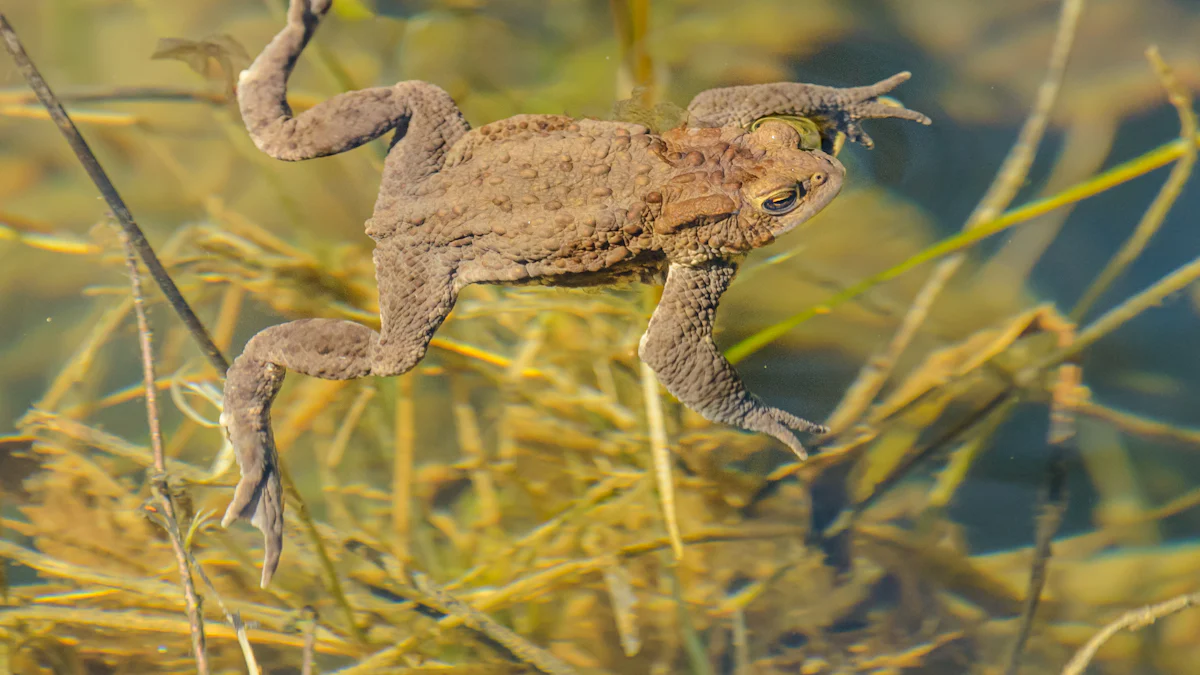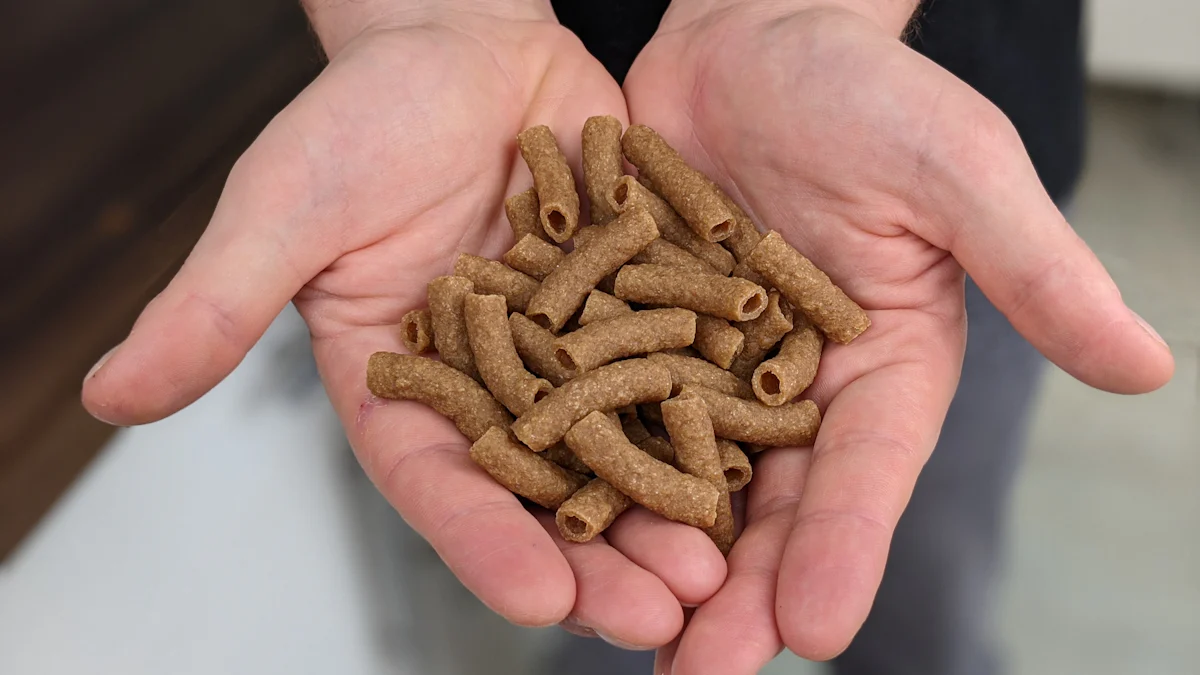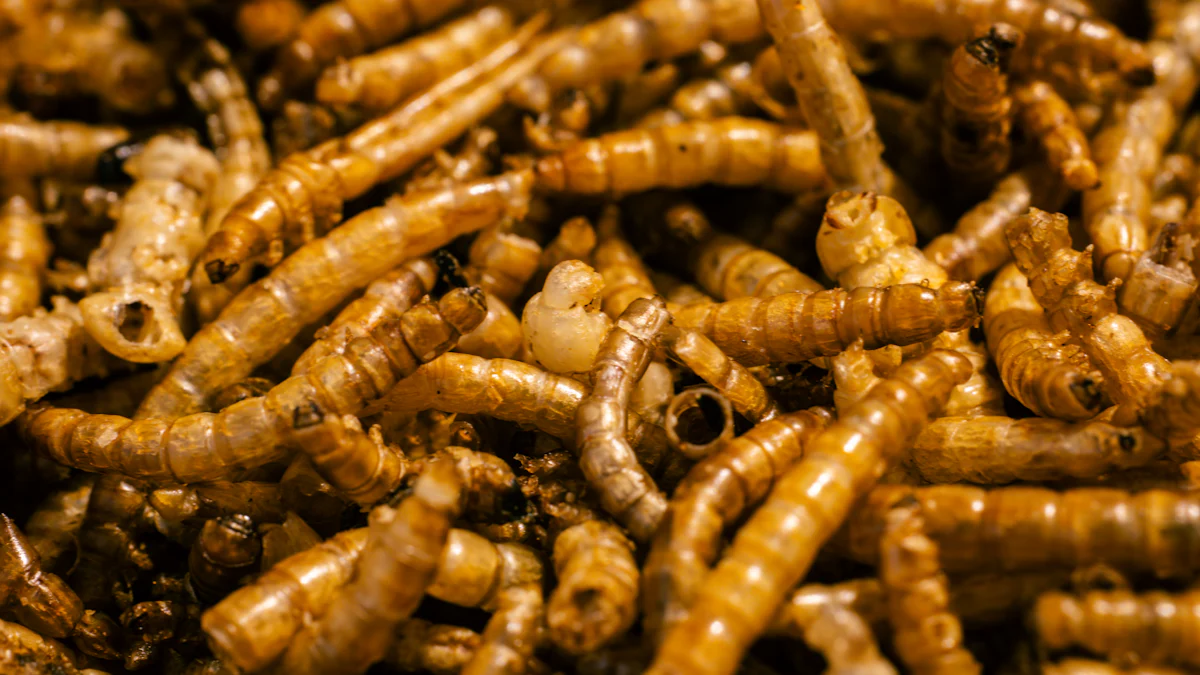
Frogs, with their diverse dietary needs, often find themselves munching on a variety of insects. But is the frog eating mealworm a good choice? Mealworms offer a protein-packed punch, especially beneficial during breeding seasons. However, frogs like the chubby frog or tree frog might prefer more active prey like crickets. When choosing frog food, consider nutritional value, ease of feeding, and species-specific preferences. Mealworms, while convenient, should be part of a varied diet to ensure frogs receive balanced nutrition. Training frogs to accept mealworms can be a fun challenge, ensuring minimal waste and maximum satisfaction.
Key Takeaways
- Mealworms can be a convenient food option for frogs, but they should not be the sole part of their diet due to their high-fat content.
- Crickets are a nutritional staple for many frog species, providing a more complete diet and stimulating natural hunting behaviors.
- Earthworms offer hydration and balanced nutrition, making them ideal for aquatic frogs and those needing easy-to-digest food.
- Commercial frog food is a practical choice, delivering balanced nutrition and convenience, but should be introduced gradually to frogs accustomed to live prey.
- Tailor your frog’s diet based on species-specific needs, ensuring a varied menu that includes mealworms, crickets, earthworms, and commercial food.
- Observe your frog’s eating habits and preferences to minimize waste and maintain a clean habitat, adjusting portion sizes accordingly.
- Training frogs to accept new food types, like mealworms or commercial diets, can enhance their feeding experience and reduce food waste.
Nutritional Value Comparison

Frog Eating Mealworm: Nutritional Insights
Frogs, with their varied appetites, often find mealworms on their menu. But what makes the frog eating mealworm a topic of interest? Mealworms offer a decent protein boost, which proves beneficial during breeding seasons. However, they fall short in other nutritional areas. Their high-fat content means they should not dominate a frog’s diet. Frogs like the chubby frog, tree frog, and horned frog might enjoy mealworms, but they also need a balanced diet. Training these frogs to accept mealworms involves patience. Owners can wiggle the mealworms to mimic live prey, enticing the frogs. This technique reduces food waste and keeps the habitat clean.
Crickets: A Nutritional Staple
Crickets stand out as a favorite among frog owners. They provide a more complete nutritional profile compared to mealworms. Rich in protein and essential nutrients, crickets serve as a staple for many frog species. Pet stores often stock them, making them easily accessible. Before feeding, owners should gut-load crickets with high-calcium formulas. This ensures frogs receive the necessary minerals for healthy growth. Frogs respond well to the active movement of crickets, which triggers their hunting instincts. This makes feeding time both engaging and nutritious.
Earthworms: Nutritional Benefits
Earthworms bring a different set of benefits to the table. They offer high protein and moisture content, making them ideal for aquatic frogs. Unlike mealworms, earthworms provide a more balanced nutritional profile. Frogs like the African bullfrog and aquatic species thrive on earthworms. These worms are easy to digest and less likely to cause impaction. Owners can find earthworms in bait shops or garden centers. Their natural wriggling motion attracts frogs, ensuring a satisfying meal. Including earthworms in a frog’s diet promotes hydration and overall health.
Commercial Frog Food: Nutritional Composition
Commercial frog food offers a convenient and balanced option for frog owners. These products often come in pellet or powdered form, providing a comprehensive mix of essential nutrients. Unlike live prey, commercial diets can include vitamins and minerals that frogs might not get from mealworms, crickets, or earthworms alone.
Benefits of Commercial Frog Food:
- Balanced Nutrition: Manufacturers design these foods to meet the dietary needs of various frog species. They ensure a mix of proteins, fats, vitamins, and minerals.
- Convenience: Owners find commercial foods easy to store and serve. No need to worry about keeping live insects.
- Variety: Available in different formulations, these foods cater to specific species like tree frogs, horned frogs, and chubby frogs.
Feeding Tips:
- Introduce Gradually: Frogs accustomed to live prey might need time to accept commercial food. Start by mixing it with their usual diet.
- Observe Preferences: Some frogs may prefer pellets over powder. Experiment to see what your frog likes best.
- Avoid Overfeeding: Follow the package instructions to prevent obesity and maintain a clean habitat.
Commercial frog food can complement a diet of mealworms, crickets, and earthworms. By offering a variety of food sources, owners can ensure their frogs receive all the nutrients they need for a healthy life.
Ease of Feeding
Frog Eating Mealworm: Feeding Ease
Frogs, with their diverse appetites, often find mealworms a convenient choice. Mealworms, being readily available in pet stores, offer an easy feeding option for frog owners. Frogs like the horned frog, tree frog, and chubby frog can enjoy mealworms, but they might need some encouragement. Owners can wiggle mealworms to mimic live prey, enticing frogs to eat. This technique not only reduces food waste but also keeps the habitat clean. However, mealworms should not be the sole diet. They should complement other food sources to ensure balanced nutrition.
Crickets: Feeding Convenience
Crickets, with their lively movements, naturally attract frogs. Frogs respond to the active hopping of crickets, which triggers their hunting instincts. This makes crickets a convenient choice for feeding. Owners can easily find crickets in pet stores, ensuring a steady supply. Before feeding, gut-loading crickets with nutritious foods enhances their value. This process ensures frogs receive essential nutrients. Crickets, being more nutritionally complete than mealworms, serve as a staple in many frog diets. Their ease of availability and nutritional benefits make them a popular choice among frog enthusiasts.
Earthworms: Feeding Simplicity
Earthworms offer a simple yet effective feeding option for frogs. Their natural wriggling motion attracts frogs, making them an appealing choice. Frogs like the African bullfrog and aquatic species thrive on earthworms. These worms provide high protein and moisture content, promoting hydration and overall health. Owners can find earthworms in bait shops or garden centers. Unlike mealworms, earthworms offer a more balanced nutritional profile. They are easy to digest and less likely to cause impaction. Including earthworms in a frog’s diet ensures a satisfying and nutritious meal.
Commercial Frog Food: Preparation and Serving
Commercial frog food offers a convenient and balanced diet for frog enthusiasts. These products come in various forms, such as pellets, flakes, and granules, catering to the diverse needs of different frog species. Preparing and serving commercial frog food involves a few simple steps to ensure frogs receive the best nutrition.
Preparation Tips:
-
Choose the Right Form: Select the appropriate form of commercial food based on the frog species. Pellets work well for aquatic frogs, while flakes or granules might suit other types.
-
Read the Instructions: Each product comes with specific feeding guidelines. Follow these instructions to provide the correct portion size and frequency.
-
Hydrate if Necessary: Some pellets require soaking in water before serving. This step ensures easier digestion and prevents choking hazards.
Serving Suggestions:
-
Introduce Gradually: Frogs accustomed to live prey might need time to adjust to commercial food. Mix it with their usual diet initially to ease the transition.
-
Observe Feeding Habits: Monitor how frogs respond to the new food. Some might prefer pellets over flakes, so experiment to find their preference.
-
Maintain Cleanliness: Remove uneaten food promptly to prevent water contamination and maintain a healthy habitat.
Benefits of Commercial Frog Food:
“Commercial diets can be nutritionally more complete for frogs, providing minerals and vitamins not typically found in live prey items.”
-
Balanced Nutrition: These foods offer a comprehensive mix of proteins, fats, carbohydrates, vitamins, and minerals, ensuring frogs receive all essential nutrients.
-
Convenience: Owners find commercial foods easy to store and serve, eliminating the need for live prey.
-
Variety: Available in different formulations, these foods cater to specific species like tree frogs, horned frogs, and chubby frogs.
By incorporating commercial frog food into their diet, owners can ensure their frogs enjoy a balanced and nutritious meal. This approach complements a varied diet, including mealworms, crickets, and earthworms, promoting overall health and well-being.
Cost and Availability
Frog Eating Mealworm: Cost and Sources
Mealworms, a popular choice for frog owners, offer a convenient feeding option. Pet stores frequently stock them, ensuring easy access for those looking to feed their amphibian friends. The cost of mealworms varies depending on the quantity and size purchased. Typically, they are affordable, making them an attractive option for many. However, frogs like the horned frog, tree frog, and chubby frog might need some coaxing to accept mealworms. Owners can wiggle the mealworms to mimic live prey, enticing frogs to eat. This technique not only reduces food waste but also keeps the habitat clean. While mealworms are readily available, they should not be the sole diet. They should complement other food sources to ensure balanced nutrition.
Crickets: Price and Availability
Crickets, known for their lively movements, attract frogs with ease. Many frog owners prefer crickets due to their nutritional benefits and availability. Pet stores regularly stock live crickets, making them accessible for frog enthusiasts. The price of crickets can fluctuate based on the season and demand, but they generally remain affordable. Frogs respond well to the active hopping of crickets, which triggers their hunting instincts. This makes feeding time both engaging and nutritious. Before feeding, owners should gut-load crickets with high-calcium formulas to enhance their nutritional value. This ensures frogs receive the necessary minerals for healthy growth.
Earthworms: Cost and Purchase Locations
Earthworms provide a simple yet effective feeding option for frogs. Their natural wriggling motion attracts frogs, making them an appealing choice. Frogs like the African bullfrog and aquatic species thrive on earthworms. These worms offer high protein and moisture content, promoting hydration and overall health. Owners can find earthworms in bait shops or garden centers. The cost of earthworms is generally reasonable, and they are often sold in bulk, providing a cost-effective feeding solution. Unlike mealworms, earthworms offer a more balanced nutritional profile. They are easy to digest and less likely to cause impaction. Including earthworms in a frog’s diet ensures a satisfying and nutritious meal.
Commercial Frog Food: Market Availability
Commercial frog food has become a popular choice among frog enthusiasts due to its convenience and nutritional balance. These products are widely available in pet stores and online marketplaces, making them accessible to frog owners everywhere. The variety of options caters to different frog species, ensuring that each frog receives the nutrients it needs.
Availability and Options:
-
Pet Stores: Most pet stores stock a range of commercial frog foods. These include pellets, flakes, and granules, each designed to meet the dietary needs of various frog species. Owners can easily find products tailored for tree frogs, horned frogs, and chubby frogs.
-
Online Marketplaces: Websites like Amazon and specialized pet supply stores offer an extensive selection of commercial frog foods. This allows owners to compare products and prices, ensuring they find the best option for their frogs.
-
Specialty Shops: Some stores focus specifically on amphibians and reptiles, providing a more curated selection of frog foods. These shops often carry brands that might not be available in larger retail chains.
Feeding Tips and Tricks:
-
Training Frogs: Frogs accustomed to live prey might initially resist commercial food. Owners can gradually introduce these foods by mixing them with live mealworms or crickets. This helps frogs associate the new food with their usual diet.
-
Avoiding Waste: To prevent food waste, owners should offer small portions and observe their frogs’ eating habits. Adjusting the amount based on consumption ensures minimal leftovers.
-
Maintaining Cleanliness: Uneaten food can contaminate the habitat. Owners should promptly remove any leftovers to keep the environment clean and healthy.
“Amphibians, including frogs, often prefer live food due to their attraction to movement. However, with patience and the right techniques, they can adapt to commercial diets.”
Benefits of Commercial Frog Food:
-
Balanced Nutrition: These foods provide a comprehensive mix of proteins, fats, vitamins, and minerals. This ensures frogs receive all essential nutrients, promoting overall health and well-being.
-
Convenience: Unlike live prey, commercial foods are easy to store and serve. This eliminates the need for maintaining live insects, simplifying the feeding process.
-
Variety: With different formulations available, owners can choose products that cater specifically to their frog’s species and dietary needs.
By incorporating commercial frog food into their diet, owners can ensure their frogs enjoy a balanced and nutritious meal. This approach complements a varied diet, including mealworms, crickets, and earthworms, promoting overall health and well-being.
Suitability for Different Frog Species

Frog Eating Mealworm: Species Suitability
Frogs, with their diverse dietary preferences, often find mealworms on their menu. Species like the horned frog, tree frog, and chubby frog can enjoy mealworms as part of their diet. However, these frogs might need some encouragement to accept mealworms. Owners can wiggle the mealworms to mimic live prey, enticing the frogs to eat. This technique not only reduces food waste but also keeps the habitat clean. Mealworms should not be the sole diet. They should complement other food sources to ensure balanced nutrition.
Feeding Tips:
- Training Frogs: Introduce mealworms gradually. Mix them with other insects to help frogs associate mealworms with their usual diet.
- Avoiding Waste: Offer small portions and observe the frogs’ eating habits. Adjust the amount based on consumption to ensure minimal leftovers.
- Maintaining Cleanliness: Remove uneaten mealworms promptly to prevent habitat contamination.
Crickets: Suitable Frog Species
Crickets, with their lively movements, naturally attract frogs. Many frog species, including the African bullfrog and tree frog, respond well to crickets. These frogs rely on movement to trigger their hunting instincts, making crickets an ideal choice. Crickets provide a more complete nutritional profile compared to mealworms. Before feeding, owners should gut-load crickets with high-calcium formulas. This ensures frogs receive the necessary minerals for healthy growth.
Benefits of Crickets:
- Nutritional Value: Rich in protein and essential nutrients, crickets serve as a staple for many frog species.
- Feeding Convenience: Easily available in pet stores, crickets offer a steady supply for frog enthusiasts.
- Engaging Feeding Time: The active hopping of crickets makes feeding time both engaging and nutritious.
Earthworms: Species Compatibility
Earthworms bring a different set of benefits to the table. Frogs like the African bullfrog and aquatic species thrive on earthworms. These worms offer high protein and moisture content, promoting hydration and overall health. Earthworms provide a more balanced nutritional profile compared to mealworms. They are easy to digest and less likely to cause impaction. Owners can find earthworms in bait shops or garden centers.
Advantages of Earthworms:
- Nutritional Benefits: Earthworms provide essential nutrients, making them ideal for aquatic frogs.
- Feeding Simplicity: Their natural wriggling motion attracts frogs, ensuring a satisfying meal.
- Cost-Effective: Often sold in bulk, earthworms offer a cost-effective feeding solution.
By understanding the suitability of different food options, frog owners can ensure their amphibian friends receive a balanced and nutritious diet. Incorporating a variety of food sources, including mealworms, crickets, and earthworms, promotes overall health and well-being.
Commercial Frog Food: Species Appropriateness
Commercial frog food offers a convenient and balanced diet for various frog species. These foods come in different forms, such as pellets, flakes, and granules, catering to the unique needs of frogs like tree frogs, horned frogs, and chubby frogs. Each species has its own dietary preferences, and commercial foods aim to meet these requirements.
Benefits of Commercial Frog Food:
-
Balanced Nutrition: Manufacturers design these foods to provide essential nutrients, including proteins, fats, carbohydrates, vitamins, and minerals. This ensures frogs receive a well-rounded diet.
-
Convenience: Owners find commercial foods easy to store and serve. They eliminate the need for live prey, simplifying the feeding process.
-
Variety: Available in different formulations, these foods cater to specific species, ensuring each frog gets the nutrients it needs.
Feeding Tips:
-
Introduce Gradually: Frogs accustomed to live prey might need time to accept commercial food. Start by mixing it with their usual diet to ease the transition.
-
Observe Preferences: Some frogs may prefer pellets over flakes. Experiment to see what your frog likes best.
-
Avoid Overfeeding: Follow the package instructions to prevent obesity and maintain a clean habitat.
Species-Specific Considerations:
-
Tree Frogs: These frogs often enjoy a mix of live insects and commercial food. Owners should ensure the commercial diet includes high moisture content to mimic their natural diet.
-
Horned Frogs: Known for their voracious appetites, horned frogs benefit from a protein-rich commercial diet. Owners can supplement with occasional live prey to stimulate their hunting instincts.
-
Chubby Frogs: These frogs require a balanced diet to prevent obesity. Commercial foods designed for chubby frogs often include lower fat content to maintain their health.
“Amphibians, including frogs, often prefer live food due to their attraction to movement. However, with patience and the right techniques, they can adapt to commercial diets.”
By incorporating commercial frog food into their diet, owners can ensure their frogs enjoy a balanced and nutritious meal. This approach complements a varied diet, including mealworms, crickets, and earthworms, promoting overall health and well-being.
Frog owners have a smorgasbord of food choices, each with its own perks. Crickets emerge as the nutritional champions, offering a complete diet that keeps frogs hopping with joy. Their lively antics make them a favorite for many species. Earthworms provide a balanced meal, especially for aquatic frogs, ensuring hydration and health. While mealworms may not top the nutritional charts, they win points for affordability and availability.
“Mealworms are not a good staple for nutritional value reasons, but they are cheap, easy to find, and can be stored for a long time.”
For those seeking convenience, commercial frog food offers a balanced diet in a tidy package. Frog owners should tailor their choices based on their frog’s species and dietary needs, ensuring a varied and nutritious menu.
FAQ
What are the best frog species for feeding mealworms?
Frogs like the horned frog, tree frog, and chubby frog often enjoy mealworms as part of their diet. Each species has unique preferences. Horned frogs, with their voracious appetites, might gobble up mealworms quickly. Tree frogs, on the other hand, may need some coaxing. Chubby frogs require a balanced diet to prevent obesity, so mealworms should be just one part of their menu.
How can frog owners train their frogs to accept mealworms?
Training frogs to accept mealworms involves a bit of creativity. Owners can wiggle mealworms to mimic live prey, enticing frogs to eat. This technique reduces food waste and keeps the habitat clean. Introducing mealworms gradually, mixed with other insects, helps frogs associate them with their usual diet.
What are the nutritional benefits of commercial frog food?
Commercial Frog Food offers a balanced diet, providing essential proteins, fats, carbohydrates, vitamins, and minerals. These foods cater to various frog species, ensuring they receive all necessary nutrients. Available in pellets, flakes, and granules, commercial diets can complement live prey, offering a comprehensive nutritional profile.
How can frog owners avoid food waste when feeding mealworms?
To minimize waste, owners should offer small portions and observe their frogs’ eating habits. Adjusting the amount based on consumption ensures minimal leftovers. Promptly removing uneaten mealworms prevents habitat contamination, maintaining a clean environment for the frogs.
Are crickets a better choice than mealworms for frogs?
Crickets often serve as a staple in many frog diets due to their complete nutritional profile. Frogs respond well to the active movement of crickets, which triggers their hunting instincts. While mealworms provide convenience and affordability, crickets offer more nutritional benefits, making them a popular choice among frog enthusiasts.
What are the advantages of using earthworms in a frog’s diet?
Earthworms bring high protein and moisture content, promoting hydration and overall health. Frogs like the African bullfrog and aquatic species thrive on earthworms. These worms offer a balanced nutritional profile and are easy to digest, reducing the risk of impaction. Their natural wriggling motion attracts frogs, ensuring a satisfying meal.
How can commercial frog food benefit aquatic frogs?
Aquatic Frog Food is specially formulated to meet the nutritional needs of frogs living in aquatic environments. It contains essential proteins, fats, carbohydrates, vitamins, and minerals. Available in various forms, such as pellets and flakes, these foods ensure proper growth and development for aquatic frogs.
What should frog owners consider when choosing commercial frog food?
When selecting commercial frog food, owners should consider the specific dietary needs of their frog species. High-quality products ensure a balanced mix of nutrients. Owners should introduce commercial food gradually, mixing it with live prey to ease the transition. Observing the frogs’ preferences helps in choosing the right form, whether pellets or flakes.
Can frogs adapt to a diet of commercial food alone?
Frogs can adapt to a diet that includes commercial food, but variety remains key. While commercial diets provide essential nutrients, incorporating live prey like mealworms, crickets, and earthworms ensures a well-rounded diet. This approach promotes overall health and well-being, catering to the natural dietary habits of frogs.


